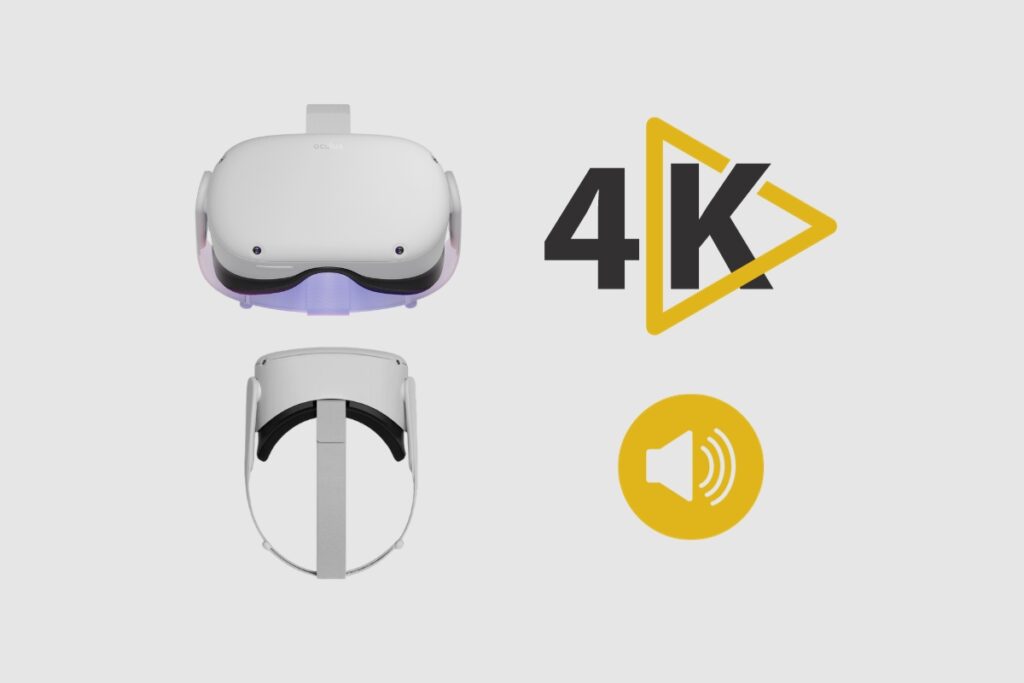The Meta Quest 2 display puts pixels right in front of your eyes, so it has the highest resolution display to experience power and speed. The resolution display has a higher pixel density with a resolution of 1832 x 1920 per eye, everything from multiplayer games and productivity apps to 360-degree videos that are about 50 per cent sharper than the original Meta Quest.
Unfortunately, the Meta Quest 2 doesn’t have a 4K display option, meaning that fans can only get an impressive level of 1080p images. It’s an impressive FHD display that gives everyone using the Meta Quest 2 a beautiful view of images and games on a screen.
Is the Meta Quest 2 a 4K Display?
Fans of the Meta Quest 2 can only acquire excellent quality 1080p images because the Meta Quest 2 does not provide a 4K display choice. Every person using the Meta Quest 2 has a stunning view of the visuals and games on the screen thanks to the outstanding FHD display, but it doesn’t hit 4K. However, with the Meta Quest 3 rumoured to have a 4K display, fans of Meta’s VR headsets should be very happy to play with the Meta Quest 3 when it launches in 2023.

The Meta Quest 2’s Display and Audio Options
The Meta Quest 2’s display places pixels directly in front of your eyes and has the best resolution available. With a resolution of 1832 x 1920 per eye, the display has a higher pixel density than the original Oculus Quest, making everything from multiplayer games and productivity apps to 360-degree videos about 50% sharper. It also has a 90 Hz refresh rate, which reduces eye fatigue.
It has a 12- to 32-millimeter lens and is a 3D camera.
Interocular distance adjustment, or lens adjustment, lessens blur depending on the eyes. Three fixed distances, 58mm, 63mm, and 68mm, can be selected for Google to move over. The ranges of the interpapillary distance (IPD) are covered by the three settings.
The internal speaker provides positional audio. Speakers are integrated into the strap support of the headset; they are powerful and clear enough to provide directional audio in both left and right stereo while allowing you to be aware of your surroundings. The sound quality of the games on this will be excellent. It provides cinematic 3D positional audio with two built-in speakers and a 3.5mm headphone connection. Additionally, a built-in microphone is available for use in games with other players. Bluetooth, WiFi, and USB-C are available as connectivity options.

The Meta Quest 2’s Performance with its Display Options
Similar to its predecessor, the Quest 2 makes use of the Guardian system, which enables you to define boundaries for your play area so that the headset can alert you if you’re about to leave it (and possibly run into something). It’s effective. For games that don’t involve a lot of movement or wandering around, the system enables you to set up a stationary circle and remember the particular locations you select.
The head tracking continues to be precise. The headset’s four cameras track your surroundings continuously to pinpoint your location, and internal sensors monitor your orientation. As indicated, the cameras also monitor motion information from the controllers. Similar to the first Quest, it is a full six-degrees-of-freedom (6DOF) experience, and it has an immersive sense.
Additionally, the improved display quality is obvious; compared to the original Quest, everything appears slightly clearer. If you look very closely, you can still see pixels, but barely. In the end, the overall experience is considerably crisper and cleaner.
Tetris Effect, which debuted on the PlayStation 4 and supported PlayStation VR, was the game I chose to start with. On the Quest 2, the game looks and sounds fantastic; it is equally immersive and has slightly sharper visuals than on the PS VR. The control method is my one gripe; Tetris calls for digital accuracy, and the DualShock 4 controller’s direction pad is great for input. The analogue sticks on the Quest 2’s controllers are a bit too sensitive, and I occasionally dropped blocks by accident.
After that, I engaged in some Gun Club VR, a shooting game. The headset precisely followed my controller motions, enabling me to aim various weaponry at pop-up targets precisely. I was able to identify distant targets and better coordinate headshots thanks to the higher-quality display, making for a fun simulator experience.
YouTube VR viewing is another option with the headgear. It creates a fake huge screen in front of you so you can watch videos as though you were in a theatre. It is user-friendly and sufficiently immersive. Once more, the sharper and more enjoyable viewing experience is a result of the higher resolution display.
Finally, I spent some time playing Beat Sabre and Superhot VR, two of my favourite VR games. In the first-person shooter Superhot VR, time only moves when you do. You can perform amazing feats of disarming and marksmanship because of this mechanism.
I was able to avoid gunfire and eliminate adversaries like John Wick because of the Quest 2’s precise head and controller tracking. In the rhythm game Beat Sabre, you slash at glowing blocks that are coming at you in time with the music’s beat. Once more, the tracking on the Quest 2 was precise. Through the headset, both games were sharp, and the 120Hz refresh rate kept the action.
Final Thoughts
While the Meta Quest 2 may not have a 4K display, it certainly does not have a bad display. Images are sharp, crisp, and detailed. The Meta Quest 2 is a great improvement on the previous version, and I expect the Quest 3, which should have a 4K display, to be even better. Thank you so much for reading this article. I hope you enjoyed reading this as much as I did writing it.
References:

